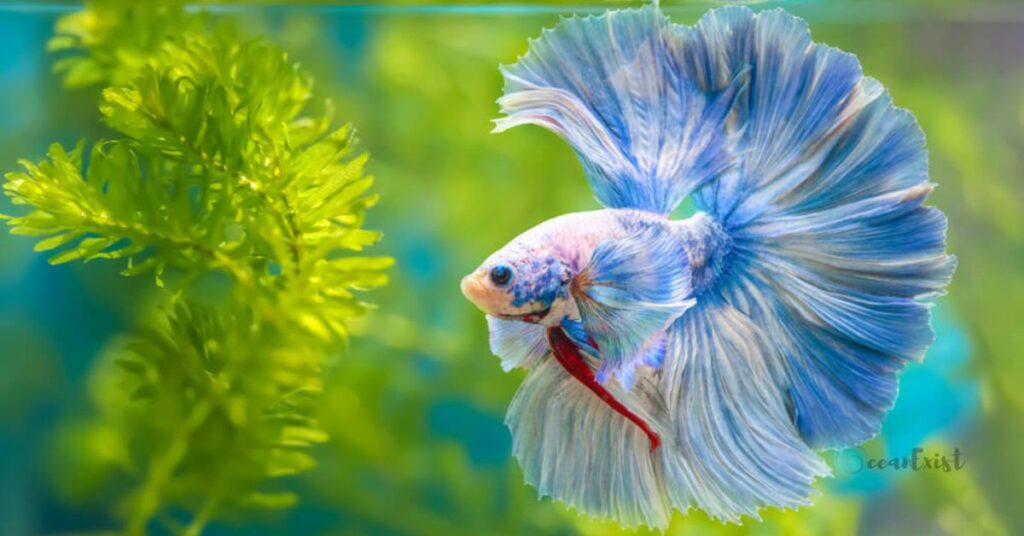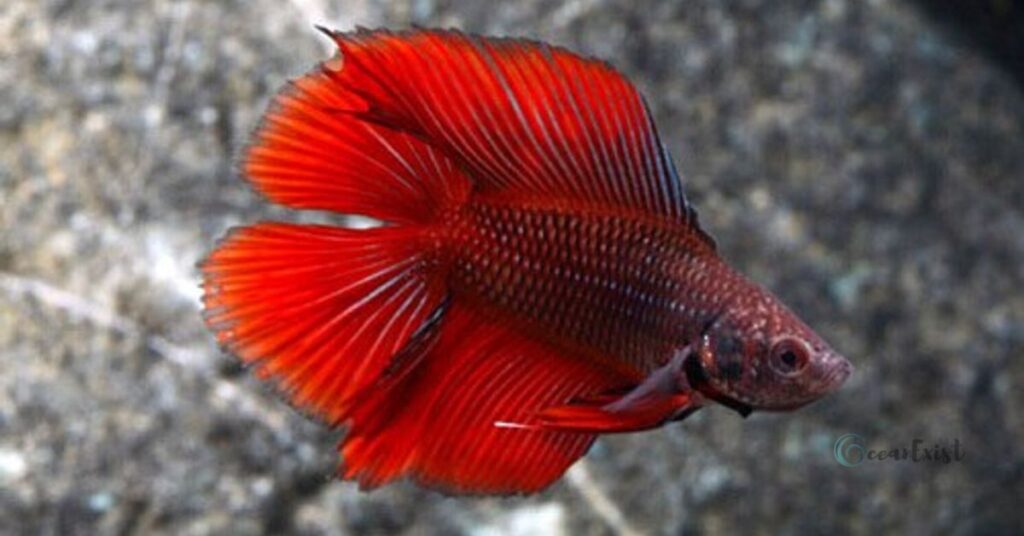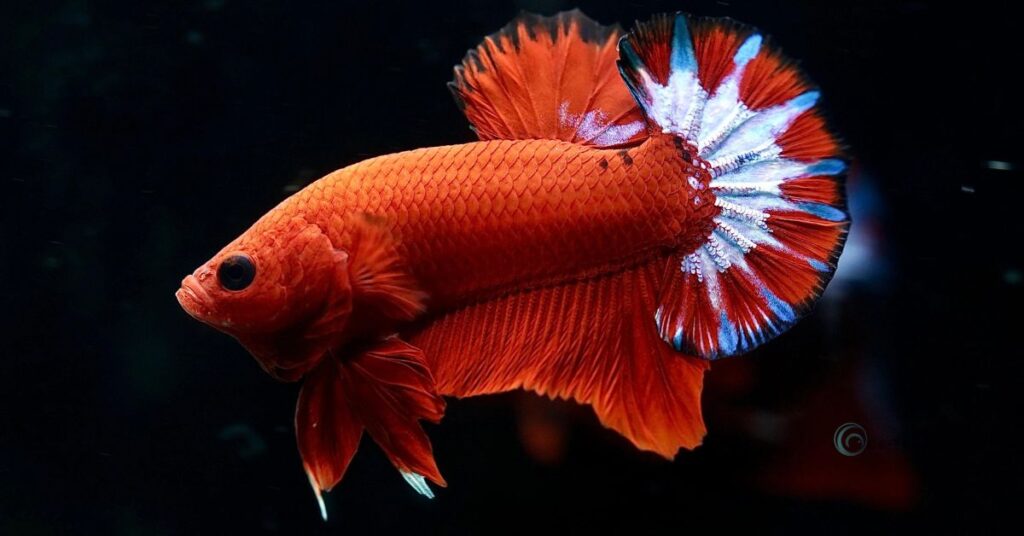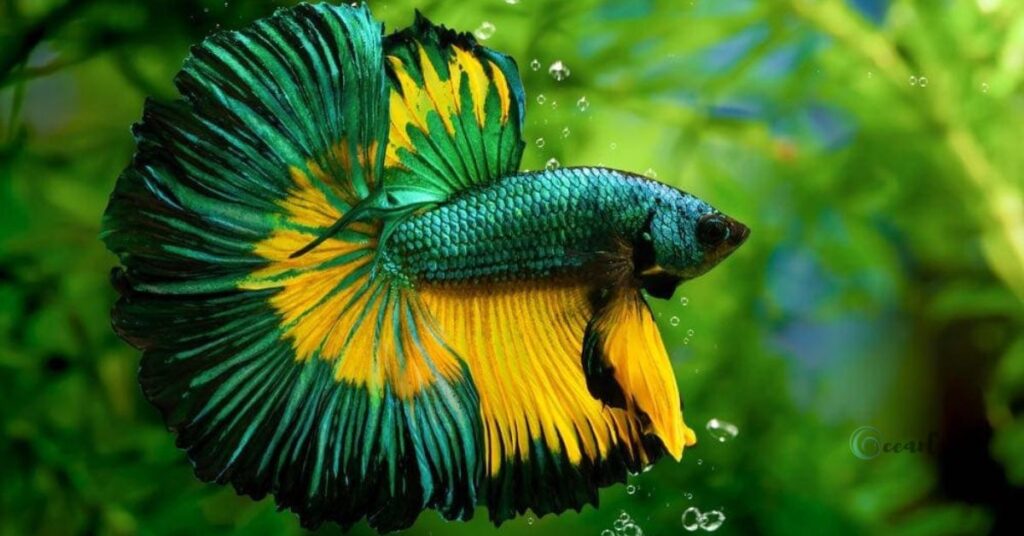Halfmoon Betta Fish are the most popular fish for aquarium hobby. They are known for their elegant half-moon-like tail fins. Their bright colors and exceptional shape of their fins include them in most-kept species of freshwater fish. Halfmoon Betta are very interesting pet fish due to their shape as well as their behavior.
If you are also fascinated with the beauty and diligence of Halfmoon Betta fish, then continue reading this article. You will find all the facts and details, including the varieties, characteristics, care, and breeding tips about Halfmoon Betta fish.
Facts about Halfmoon Betta Fish
| Scientific Name | Betta splendens |
| Life Span | 2-4 years |
| Colors | Black, red, blue, clear, purple |
| Size | 1-3 inches |
| Temperament | Active, hungry, aggressive |
Halfmoon Betta Fish Characteristics
Halfmoon Betta Fish Appearance
There are a large number of varieties of Betta fish all different in their fin patterns and colors. These are actually produced by crossbreeding between different species.
Halfmoon Betta fish is one of the variants of Betta fish. As their name describes, they have 180-degrees arc of fin just like a halfmoon. Halfmoon Bettas are not only distinctive in their rounded fin but have a variety of colors and an interesting personality. Halfmoon Betta fish male have larger fins while females have smaller fins. They expand their fins when they sense any threat.
Halfmoon Betta fish has a round shape body, a small mouth, and blunt teeth. The teeth are not very sharp. That’s why Betta fish prefers to eat soft food.
Halfmoon Bettas have fascinating bright versions of colors like deep red and deep blue. Only their appearance differentiate them from other types of Bettas otherwise they have the similar characteristics. Halfmoon Bettas also breathe through gulps taking off the surface.
Behavior Of Halfmoon Betta
Betta fish are popular for their aggressive nature. Same is the case with the Halfmoon Bettas. Halfmoon male are very territorial and can’t compromise any other fish, especially male in their close vicinity. They will instinctively attack when any fish enters their area. That’s why they are called the Siamese Fighting Fish.
Halfmoon Betta fish males may tolerate female Halfmoon Betta fish, but only for a specific time of breeding. They love to live alone in the tank due to their solitary nature. Therefore, you will only find peaceful Betta when they are alone.
When Halfmoon Bettas are under stress, their fins become tight and stiff. They move very fast and hit themselves into different things in the tank. These signs reflect that Halfmoon Bettas are feeling threatened and are ready to attack. On the other hand, the fins of Betta Fish become placid and flow gently, smoothly, and calmly when they feel relaxed and happy.
There is a chance that Halfmoon Betta will recognize its owner, especially during feeding time. They start swimming fast and energetically.
SUMMARY
Halfmoon Betta fish have a round-shaped body and arc fins. The males have larger fins than the female Betta fish. They have a small mouth and blunt teeth. Halfmoon Betta fish tend to live alone. They are aggressive and hostile. Under stress, their fins become tight and stiff.
Origin or History of Halfmoon Betta Fish
Origin of the Halfmoon Betta fish is from the Southeast Asia rivers. These include the waters of Thailand, Cambodia, Vietnam, and Laos.
In the past, people bet on the fights of Betta fish. This practice made them famous among the people of Thailand and Malaysia.
The Halfmoon Bettas now are totally different from their ancestors as these are the result of selective breeding over hundreds of years. Europeans kept Halfmoon Betta fish as pets, especially in Germany, France, and Moscow.
With selective breeding, scientists and Betta enthusiasts produced the Halfmoon Betta. People started to like them due to their beauty not due to their aggressive nature. So it was kept as a piece of beauty in different places. With the passage of time, different crossbreeding experiments resulted in a large variety of Halfmoon Betta fish varieties with different fins’ colorations and patterns.
Halfmoon Betta Fish Types

Halfmoon Betta fish are the most attractive and the most kept species of Betta fish. These are actually differentiated by their color variants and tail variants.
Halfmoon Betta Tail Variants
- Dumbo Halfmoon or elephant ear Halfmoon has large dorsal and pectoral fins.
- Rosetail Halfmoon has fins just like the petals of rose with multiple folds and ruffles. These are the results of selective crossbreeding.
- Twintail Halfmoon has a split tail fin from its middle. So it has a double tail.
- King Halfmoon has a large body and a small tail fin. Its body is sleeker, but its tail is less flowy.
- Over Halfmoon is an extreme version of Halfmoon Betta. It has more fins than half-moon or 180 degrees.

Halfmoon Betta Color Variants
- Solid Colored Halfmoon Betta are popular for their single solid color. These colors are metallic colors like silver and bronze. They also come in blue, white, and red colors.
- Bi-colored Halfmoon Betta have two colors on their body. These are the most common Halfmoon Bettas in the market.
- Dragonscale Halfmoon has bright and dragon’s armor-like scales on their body. These are actually produced by crossbreeding between wild Betta Mahachaiensis genes and regular aquarium Bettas.
- Marble Halfmoon has marble-like coloration due to the light colors with patches of irregular vivid colors in them.
- Koi Halfmoon has many irregular color patterns on them. These colored patches include orange, white, black, and gray.
- Mustard Gas Halfmoon has two colors. These include the mustard yellow and other dominant color like black, red, white, or blue.
- Butterfly Halfmoon has two colors, one light, and one dark, just like Mustard Gas Halfmoon.
Betta Fish Care Guides

Halfmoon Betta fish are not easily maintained pets. Although they have a labyrinth organ, it doesn’t mean that these Fish can live without any care. Poor water maintenance will expose Betta Fish to diseases, especially fin rot.
Therefore, when you are going to have a Halfmoon Betta fish as your pet, try to mimic the ideal natural environment. Moreover, to keep Halfmoon Betta Fish healthy and happy, the conditions of the tank should be just like wild water and surroundings.
Tank Setting for Halfmoon Betta Fish
Tank Size
When setting a tank for Halfmoon Betta fish, firstly comes its size. A minimum of 5 gallon water tank is suitable for Halfmoon Betta fish. Experts suggest that a tank of 10 gallons size will prove ideal for keeping a Betta fish. It will reduce the chances of a shock to Betta fish. There will be enough room for a Halfmoon to roam around.
If the tank size is large, you don’t have to clean it frequently. And your Betta fish will not be afraid of any sudden changes.
Plants in Halfmoon Betta’s Tank
Halfmoon Betta fish love to hide behind the leaves. So try to keep plants with large leaves. For this, you can use both live or plastic plants. For Halfmoon Betta, both plastic and live plants are equal as it doesn’t use their oxygen. As the fins of Betta fish are very sensitive, therefore the plants used in tank must be soft.
Along with plants, keep some rocks and decorations to make the surroundings of Betta fish beautiful.
Water
The water in the tank must be soft. The degree of General Hardness must be between 5 and 20.
The tank water must have a moderate temperature. It should be between 72-degrees and 81-degrees. The ideal water temperature is 75 degrees for a Halfmoon Betta.
The pH of the water must be maintained between 6.8 and 7.5. It should be neither highly acidic nor highly alkaline.
Moreover, the water current must be slow. Halfmoon Bettas like slow and calm water instead of rapid or strong currents.
Water conditioners, pumps, and filters are used to maintain the above water conditions. They will keep all the conditions regulated according to the fish type.
Lighting
As the Halfmoon Betta fish are sensitive, they are soft and light. According to experts, the timing of lighting must be similar to the natural day and night cycle. It will keep them healthy by giving them enough time to sleep well.
Therefore use fluorescent lights or led bulbs for lighting the tanks. You must use a timer for maintaining the timetable of lighting according to the day even when you are not there.
Tankmates
Halfmoon Betta Fish are aggressive and territorial in nature. The male Halfmoon Betta fish dispute with other Fish when they come in the same tank. Males will only tolerate female Betta fish only for a specific time. Therefore, try to keep them alone.
However, you can keep some species with Halfmoon Bettas. But be very cautious when choosing a tank mate for them. Here is a list of some species which are considered appropriate tank mates of Halfmoon Betta fish.
- Pleco
- Snail
- Ghost shrimp
- Feeder guppies
- Harlequin rasbora
- Tetras
Feeding Halfmoon Betta
Betta fish are carnivores but you can feed them with a variety of food. However, they like to eat proteinous food. When feeding them, live meat will be their favorite food to eat. You can feed Halfmoon Betta fish with the following things.
- Pellets and flakes are a commercial diet that has all the nutrients in a balanced amount.
- Live meat and frozen food which include brine shrimp, daphnia, and bloodworms are considered the best diet for Halfmoon Betta fish.
- Mosquito larvae can be a good diet for your Halfmoon Betta fish.
- Soft vegetables that include the blanched lettuce, spinach, or pea can provide the vitamins and fibers for digestion to Halfmoon Betta.
When it comes to the frequency of feeding, you can feed them once or twice a day. But be careful about the frequency and quantity of food and maintain a balanced diet. Betta fish will continue eating till the food is finished. Therefore, feed them in a balanced quantity and regularly with a gap of 12 hours.
SUMMARY
A five-gallon tank is suitable for Halfmoon Betta fish. Optimum pH and temperature are necessary to keep Betta fish in tanks. Use soft plants in the tanks, as the fish are aggressive and tend to live alone. Carefully feed the fish at regular intervals. Meat, pallets, and soft vegetables are the best diet for Halfmoon Betta fish.
Betta Fish Breeding and Selection

Breeding of Halfmoon Betta is not a difficult process but requires careful attention. The ideal age for breeding a Halfmoon Betta fish is between 4 months and one year. And if you want to breed them, keep them separate from any other tank mates.
Ideally the male must be larger than the female for a perfect pairing. If you are also interested in breeding your pet Halfmoon Betta fish, then follow the below given steps.
- Select healthy, mature, genetically diverse, and active Halfmoon Bettas. Before breeding, maintain a highly proteinous diet.
- Keep the ideal conditions for both the male and female Bettas.
- Put something neutral that can float. Male Betta fish use that floating thing for nesting.
- Put the pair in tanks with ideal conditions and provide them with proteinous food for 2-4 weeks.
- Maintain a transparent separation.
- They must be able to see each other.
- When both male and female show signs such as darkening of their colors and certain movements, introduce them to each other.
- But make sure the male is not attacking or harassing the female.
- After some time, when they are ready for mating, male Halfmoon Betta builds a bubble nest.
- The female Halfmoon Betta will lay eggs in that nest.
- After the female has laid eggs, the male will fertilize them.
- Now, spawning has started.
- The male will take care of these eggs and fry them after hatching.
- In the very last step, maintain proper diet and water conditions.
- The fry will need nutritious food for fast growth.
- In this step, the parents return to their tanks.
Yes, this process requires attention, care, and patience, but it is an interesting process. You will be rewarded with so many beautiful young Halfmoon Betta fish.
Conclusion
Summarizing the whole discussion, Halfmoon Betta fish is not only one of the most beautiful fish in the world but an interesting fish to keep and study. And in this article, you will find each and everything a Halfmoon Betta keeper must know. This blog post includes nature, environment, feeding, and breeding, even its types.
Hope you enjoyed reading this blog!
